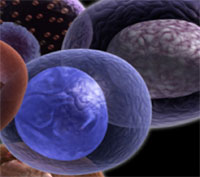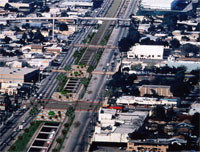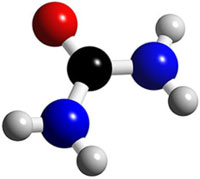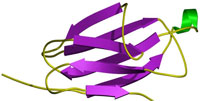Fluid and Solute Removal: How and Why (Part One)
Article by John Agar, MD
Barwon Health, Geelong, Australia
www.nocturnaldialysis.org
There are three main reasons why I think longer and/or more frequent hemodialysis (HD) are better for you:
- You'll feel better during and after HD.
- More HD is much better for your heart and circulation.
- More HD more gently—yet also far more completely—restores the chemistry of your blood and body.
Fluid in your body
Your body has three distinct fluid "compartments":
- 1. Inside your cells.
-
 Each cell of your body is a tiny living building block. The sum total of your cells makes up the tissues and organs of your body. Like your cells, a watermelon looks solid—and if you dropped one on your foot, you would agree it feels solid. Yet, a watermelon is 97% water.
1
Cells are like that, too. They have structure, yet they are mainly water. The water that makes up the bulk of your cells is the "intracellular fluid compartment" —fluid
inside
your cells.
Each cell of your body is a tiny living building block. The sum total of your cells makes up the tissues and organs of your body. Like your cells, a watermelon looks solid—and if you dropped one on your foot, you would agree it feels solid. Yet, a watermelon is 97% water.
1
Cells are like that, too. They have structure, yet they are mainly water. The water that makes up the bulk of your cells is the "intracellular fluid compartment" —fluid
inside
your cells.
- 2. Between your cells.
-
Cells live in a kind of primordial "soup," a fluid bath that nourishes them and keeps them fed and happy. This is the "extracellular fluid," the fluid
outside
your cells. It is also called the "interstitium" (in between), the "extracellular fluid compartment" or the "interstitial fluid compartment"—just to confuse the hell out of us!
This compartment has a somewhat different content of salts (electrolytes) than the fluid inside the cells—especially for salts like sodium and potassium.
- 3. The bloodstream.
- Finally, there is your blood itself: a mixture of water, salts, proteins, and cells. Red blood cells carry oxygen. White cells offer us protection and immunity. And tiny cells called platelets help the blood to clot in response to injury. Blood carries oxygen and nutrients to supply the cells. It also carries away the wastes and toxins your cells make as they do their daily work.
Life in the fast lane...
It may help you to think of your body as a huge city. Your blood vessels are a road system. The "arterials," smaller highways, lanes and alleys, are all full of cars and trucks. Red cells deliver goods and services. White cells are police and emergency services. And proteins and other carriers are the garbage trucks.
Single cells are the people in your city. They work and function independently of each other—but also together in groups. In a real city you might call these groups organizations. In the body, we call them organs.
Day by day, you work in an environment made up of your home, office, and suburb. They form your support systems, the "interstitium" that surrounds and nurtures you. It acts as the interface between you and the roads that bring your goods and dispose of wastes. Anything you need or that must be thrown out must first come from or go to the road system. It must be carried into or out of the house or the office. You know this can be a quick-as-a-wink delivery or pick-up, like a mail delivery or an empty bottle to throw away. Or, it can be slow and laborious: a piano to get up a top-floor apartment or a king-sized bed or sofa to manhandle up the stairs.
It is the same in your body. Cells are fed and cleaned by deliveries back and forth through the interstitium. In turn, the interstitium is fed and cleaned by the blood stream. Any waste made by the cells must first pass into the interstitium then through the interstitium and into the blood before it can be carried away.
 But, you know, it can take time to offload a truck, to carry things in and carry things out again. Putting out the trash also takes time. Little things are easily carried and don't take long, but bigger things take longer and need more effort. They may even need special lifting and carrying devices to shift them. Time, frequency of delivery and removal and ease of transport —these things really
do
matter!
But, you know, it can take time to offload a truck, to carry things in and carry things out again. Putting out the trash also takes time. Little things are easily carried and don't take long, but bigger things take longer and need more effort. They may even need special lifting and carrying devices to shift them. Time, frequency of delivery and removal and ease of transport —these things really
do
matter!
Bringing it back to dialysis
So...what has all this got to do with the speed, length, and frequency of HD and how you feel during, after, and between HD sessions?
Here's the thing: HD can only directly access your bloodstream. It can only directly clean your blood. It does not access your cells. It does not have direct contact with the environment—the interstitium—in which your cells live and work. Any substance that is removed by HD must be, at least at first, removed from your blood alone.
Okay...focus here...it is crucial that you understand this next bit!
When HD removes a waste or fluid from your blood, it only reduces your blood level of that substance. When your blood level drops, a gradient (difference) forms between the blood and interstitium. This occurs because now the interstitium has more of the substance than your blood does.
Your body wants fluid, salts, and wastes to be in balance between your three fluid compartments. Keeping this balance, called homeostasis, is the main job of the kidneys. To restore balance, dissolved substances (solutes) always move from a compartment with higher level to one with a lower level. 2
 So, as the blood level of a solute falls, this forms a gradient (a concentration difference) between your blood and interstitium. The solute will then move out of the interstitium and back into your blood. And
this
creates a
second
gradient between the interstitium and your cells. In this way, removing "X" from your blood will remove "X" from your interstitium, which, in turn, will remove "X" from your cells.
Each of these steps takes time.
So, as the blood level of a solute falls, this forms a gradient (a concentration difference) between your blood and interstitium. The solute will then move out of the interstitium and back into your blood. And
this
creates a
second
gradient between the interstitium and your cells. In this way, removing "X" from your blood will remove "X" from your interstitium, which, in turn, will remove "X" from your cells.
Each of these steps takes time.
Bringing back balance
 Between HD treatments, your three compartments equilibrate—levels of wastes and fluid become equal. But,
during
HD, a sort of "waterfall" occurs as the treatment first plunders the blood. Some solutes move quickly from one compartment to another. Others are more sluggish. How efficient removal of a solute from the interstitium and the cells can be depends on how fast it can move and how much of it can be removed. And this depends on the "leak rate" of the solute from your cells to your interstitium and then to your blood.
Between HD treatments, your three compartments equilibrate—levels of wastes and fluid become equal. But,
during
HD, a sort of "waterfall" occurs as the treatment first plunders the blood. Some solutes move quickly from one compartment to another. Others are more sluggish. How efficient removal of a solute from the interstitium and the cells can be depends on how fast it can move and how much of it can be removed. And this depends on the "leak rate" of the solute from your cells to your interstitium and then to your blood.
Waste (solute) removal
Metabolic wastes are the leftovers your cells make as they use nutrients and do their tasks for your body. To remove these wastes, they must first pass through your cell walls and into your interstitium. Then, they need to pass across the interstitium to your bloodstream. Once they reach your blood, HD can finally remove them.
Most small wastes are easy to carry and fast to move. They pass quickly from the cells to the interstitium and then into your bloodstream. Urea is like this. So, too, is potassium.
Big wastes take a lot more time. They are slower to move and can be hard to maneuver around tight corners—a bit like if you had to carry a king-sized bed up two flights of stairs. Beta-2 microglobulin, which can cause a toxic build up of amyloid in your bones and joints, can behave like this. So can homocysteine, an amino acid that raises your risk of heart problems.
Some solutes which are small and ought to be easy to move just aren't. They can be very hard to clear from your blood with HD. Phosphate is like this. We still don't know why some solutes are contrary and hard to remove. So, some wastes really zing from cell to interstitium to blood, and then across the dialyser membrane and away...whoosh! Others are plodders—they seem to take forever or won't budge much at all.
In the simplest terms, this is why there are so many differences in the efficiency of solute removal. This is why some solutes need longer HD treatments, more frequent HD or, best of all, both longer and more frequent HD to remove them.
Dialysis "adequacy" and urea
 For years, urea—a small solute that is easy to remove (and cheap to measure)—was used as a marker for HD. Tracking urea, it was thought, could tell us about other solutes that weren't as easy to measure but which presumably behaved just like urea. Some still hold to that idea...but I cannot. To me, that is a classic head-in-the-sand approach.
For years, urea—a small solute that is easy to remove (and cheap to measure)—was used as a marker for HD. Tracking urea, it was thought, could tell us about other solutes that weren't as easy to measure but which presumably behaved just like urea. Some still hold to that idea...but I cannot. To me, that is a classic head-in-the-sand approach.
I believe we now better understand that there are limits to the how well and how quickly a wide range of uremic wastes can pass from one compartment to another:
- Urea passes down a concentration gradient. The greater the difference between the two compartments, the greater the gradient and the faster the speed of diffusion (passing through the cell walls and through the interstitium).
- Phosphate, on the other hand, diffuses linearly against time. The longer the HD session, the more of it is removed. Phosphate removal has little to do with the concentration (except very early in the HD treatment). For phosphate, it is simply the length of the treatment that matters.
- The "bigger boys"—so-called middle molecules like beta-2 microglobulin and homocysteine—move slowly. They also don't squeeze easily through the membranes of any but the leakiest (high flux) dialysers. If a dialyser with small "holes" and/or a smaller number of "holes" (low flux) is used, these wastes just won't be removed—which can cause long-term health problems for you.
- Then there are substances like p-cresol, a toxin that may contribute to hospital stays in people on HD, 3 which are bound to proteins in the blood. As none of the dialyzer membranes now on the market let proteins pass through, these toxins can't get out. Protein-leaky membranes are in the pipeline, and we have been trying them here in Australia.
 Think of this: in peritoneal dialysis (PD), the peritoneal membrane allows protein through. An HD membrane does not. Though the efficiency of PD (judged by urea clearance and weekly Kt/Vurea) is much
less
than HD, the well-being of PD patients is better than it
seems
it should be, based on urea clearance alone. It is thought that some of the well-being of patients on PD may be due to removal of toxic, protein-bound wastes—like p-cresol— that pass freely through the peritoneal membrane yet remain locked "on board" in HD.
Think of this: in peritoneal dialysis (PD), the peritoneal membrane allows protein through. An HD membrane does not. Though the efficiency of PD (judged by urea clearance and weekly Kt/Vurea) is much
less
than HD, the well-being of PD patients is better than it
seems
it should be, based on urea clearance alone. It is thought that some of the well-being of patients on PD may be due to removal of toxic, protein-bound wastes—like p-cresol— that pass freely through the peritoneal membrane yet remain locked "on board" in HD.
I hope you have begun to understand that urea is "a zinger" but phosphate is "a plodder" and that measuring the removal of urea by Kt/Vurea, a value that many patients on dialysis are used to hearing as a measure of dialysis "adequacy" doesn't teach us much about any of the other wastes. It only tells us about urea. This is why many (me included) are disenchanted with Kt/V urea and think it is hardly worth the paper it's printed on. The one thing Kt/V urea has done is to set a minimum dialysis dose for all patients to achieve.
Do we need a Kt/Vphosphate, a Kt/Vβ2 microglobulin, a Kt/Vwhatever? Maybe, but that could get very messy. A better way to measure "good dialysis"—and this might include Kt/Vurea, measures of body fluid levels, and possibly of middle molecule removal too—is badly needed but sadly lacking. Is this so hard? I don't think so; it is simply that we have been so locked into Kt/V urea that we have been blinded to better ways to assess "good" dialysis. So, watch this space!
At the end of the day, short and/or infrequent HD sessions may just not be enough to make headway against some of the more complex, transport-resistant, stubborn wastes—yet some of them may be the most crucial of all to get rid of to prevent long-term complications.
References:
- Food facts & trivia: water; accessed November 2007.
- How dialysis works; accessed November 2007.
- Toxicity of free p-cresol: a prospective and cross-sectional analysis; Clinical Chemistry; accessed November 2007.

